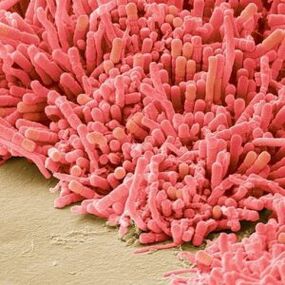
Papilloma is a benign skin neoplasm, its characteristic feature being the base of the connective tissue papilla covered epithelium above. Papillomas appear in humans in various areas of the body (on the skin, mucous membranes, in internal organs and other localizations) and in most animals.
A papilloma develops from a transitional epithelium or squamosa into a form of soft dense formation on a so-called stalk. The size of this formation usually ranges from 1 to 2 centimeters, and the outer surface has a white or dirty brown color. Sometimes papillomas grow in different directions and become like cauliflower or a rooster comb.
Papillomas are removed for cosmetic effects if they appear on visible parts of the body - on the neck, arms, face, however, if they occur in many areas of the mucous membranes, for example, on the larynx, patent-provoking disorders that threaten the patient's life. In the case of the larynx, the papilloma can block the airways, causing problems with the voice or inability to breathe normally, in the case of the bladder, the papilloma provokes hematuria. If multiple papillomas form in the body, then this indicates the onset of papillomatosis.
Papilloma etiology
For the most part, the occurrence of papilloma is provoked by a viral infection - human papillomavirus (HPV), although sometimes papilloma can occur congenital or as a complication of inflammatory disease.
When HPV enters the human body, its activity usually begins to manifest after so long. Often, several provoking factors contribute to the activation of papillomavirus, as soft neoplasms begin to appear on the skin or mucous membranes. The main factors that provoke papilloma, specialists include stress, decreased endurance, weakness of the body due to treatment, lack of vitamins in the body, injuries to the skin.
Basically, people are sexually infected with papillomavirus, however, cases of domestic infection with very low immunity or if there are damaged skin areas on the body that may be in contact with HPV carriers are also possible. The appearance of papilloma indicates the activation of an existing virus, which is equally possible for both women and men. An infant can be infected with this virus while passing through the birth canal of an infected mother.

Classification of HPV manifestations
Human papillomavirus that infects the mucous membranes and skin can be classified into the following forms:
- clinical forms that can be detected during routine examination: genital warts, papular and papillary warts, exophitic warts, as well as cervical and cervical erosion in women;
- subclinical forms, in which formations have no symptoms, they are invisible and can only be detected during endoscopy: inverted formation (growing inward in the mucous membrane), flat warts, and even warts in the cervical canal;
- latent form, characterized by clinical absence and detected exclusively by analytical results;
- female form or cervical shape, expressed by cervical cancer or multi-stage dysplasia.
When women are infected with highly oncogenic HPV as a result of sexual intercourse, the likelihood of malignant neoplasms in the cervical canal increases dramatically. When infected with other types of viruses, the chances of oncology are not so high, however, cancerous tumors can occur in the rectum or oral cavity. In men, the possibility of cancer caused by HPV is found in the anus, penis and rectum.
Types and shapes of papillomas
It is very important to identify the papilloma that appears in the body properly. Their type depends directly on the tension of the resulting virus, which, entering the human body, contributes to the process of excessive cell division in the skin, which results in papilloma.
HPV strains can be oncogenic and non-oncogenic. There are many other non-oncogenic types and, as a rule, they bring nothing to the patient except external aesthetic discomfort.
Such manifestations can be easily removed, thus solving the problem. However, if neoplasms arise in the mucous membrane area, this indicates a serious pathological process. Such dislocation means that a person has been infected with oncogenic HPV strains, therefore, complex antiviral therapy is essential. To distinguish between different types of papillomas, simply compare them to each other and identify the special features of one or another subspecies.

Simple warts
Simple papilloma or warts are the most common type of papillomavirus caused by several strains at once. The HPV strain is transmitted not only sexually, but also through relationships and daily life, leading to statistics showing that 30% of the world's population has contracted the HPV at least once in their lifetime.
Moderate papilloma or vulgar (normal) warts are more common than elsewhere found on the upper part of the foot, i. e. in the hands, but sometimes they can also occur on the body, soles and feet, palms, fingers. Their peculiarity is that such warts appear in places with damaged skin due to decreased local immunity. Such papillomas occur in the soles of the feet or palms due to contact with low-quality household chemicals, excessive sweating, various damage to the skin, dermatitis.
Vulgar warts externally look like papillary neoplasms of skin a few millimeters in diameter at the beginning of the disease. In this case, the wart head has a homogeneous and soft texture and rises above the surface of the skin. It is poorly pigmented, and its roots go into the skin, where it gets nutrients from the vessels. As a result of such a diet, warts gradually grow, while their size not only changes, but also the degree of pigmentation. Also, hair often grows in the center of such papillomas, which are a variant of the norm and do not show malignant neoplasms.
Papilloma rata
Skin growth like this looks like a small yellowish flat plaque that rises slightly above the skin surface. Its structure is dense, with deep subcutaneous roots, as evidenced by frequent pain when pressing warts or with its daily damage. Localization of such papillomas is most common on the face and hands. Sometimes it can occur in the anus or labia majora in women and scrotum in men. Due to the active blood supply, they have an active ascending flow.
The main feature of flat papillomas is the difficulty of their treatment. After this neoplasm surgery, scars and scars usually remain in place.
Genital warts
Genital warts occur in the groin or mucous membranes. Externally, this is a thin papillary neoplasm 2-3 millimeters in diameter. Such condylomas grow rapidly, forming large skin growths from small single papillae, resembling cauliflower or chicken pox.
The main danger of genital warts is the high risk of infection, inflammation of the neoplasm in the vagina or labia minora in women. They are easily injured, after which the infection penetrates into the body at high speed. Also, a major problem associated with genital warts is the high risk of recurrence, which is not reduced even with the use of antiviral treatment and with the removal of neoplasms. Some types of viruses can cause genital warts, some of which can harm women in terms of malignant processes.

Papilloma Filiform
A threaded papilloma with a thin stem, the top of which is crowned by a neoplasm head. They are very difficult to confuse with other species because of their special appearance, therefore, by looking at photos of filament papilloma, they can be distinguished from other species.
Such neoplasms appear most often after the age of 45 in areas where thin skin occurs - in the chest, armpits, neck. Such an increase in the size of such neoplasms is their elongation. The head of the filament papilloma is usually yellowish or pink, pigmentation is not specified, usually very weak.
Internal mole
Any neoplasm on the surface of a person's internal organs can be classified as a subgroup of internal moles. These are intragastric condylomas, papillomas in the rectum, neoplasms in the throat and mouth, neoplasms in the bladder wall. A special feature of these papillomas is the impossibility of their recognition without carrying out appropriate medical procedures and diagnostics. However, the disease can be suspected by special symptoms. The danger of such neoplasms is identified in each case.
If there is a papilloma in the bladder, bleeding or cancer can develop over time.
If the papilloma is located in the larynx, it helps restrict breathing and interfere with the person's speech function.
Lewandowski-Lutz Papandoma
Warty epartmodysplasia or Lewandowski-Lutz papilloma is a very rare pathology that affects only children or adolescents. It happens that such diseases can be inherited and spread in the family.
The clinical picture of the disease manifests itself in the form of many red-brown spots warts on the feet and hands. A characteristic pathology is the fact that when papillomas are located in areas of the body exposed to ultraviolet radiation, in a third of all cases, they are reborn into malignant neoplasms and grow into nearby tissue areas.

Papilloma localization location
Fililloma filaments, vulgar or pointed, as well as condyloma, are the most common in medical practice. The localization of filamentous warts is the face, which is more vulgar in the feet or hands, and condyloma exclusively on the mucous membranes (head of the penis and urethra in men, in the labia minora and vagina in women), but the occurrence of these warts can occur inan unusual place for themselves.
It is not difficult to get rid of such papillomas in modern conditions, but the danger is the fact that with reduced immunity, new papillomas can reappear, which will lead to more serious health consequences, for example, subsequent genital warts with cervical cancer development onwanitarahim. Plantar warts are most common on rough soles and toes. Sometimes, thorns can grow on the thumb after severe damage to the skin in the area.
In general, papillomatosis is a common pathological form, in which neoplasms form throughout the human body. This growth is characteristic, therefore, after seeing the manifestations of this disease once, it can no longer be confused with other diseases.
Symptoms of HPV
The most common symptom of papillomavirus in the human body is the appearance of papilloma on the skin.
The rest of the symptomatology depends on the location and type of disease. Depending on the above signs, the symptoms of HPV may be as follows:
- Genital warts occur on the mucous membranes of the genitals, mouth, larynx, rectum and on the inner surface of the abdomen. Symptoms of pathological onset in the genital area are itching and unpleasant odor. If such symptoms begin to interfere, it should not be ignored, as the cause of its occurrence may be oncogenic.
- Intracellular papilloma in the area of the mammary gland ducts, the symptoms of which are redness in the nipple area, slight itching and burning. Also, if you press the nipple with such a papilloma, then the ichor or green discharge starts to come out of it. The danger of intraductal papilloma is gradual degeneration and may become breast cancer.
- Plantar warts are expressed in active vessels in the soles of the feet, which, when walking or pressing, cause pain in sharp form.
- Papilloma in the larynx area is not initially expressed in certain symptoms, but gradually this pathology leads to changes in a person's voice, a feeling of coma in the throat, and impaired respiratory function. Also, patients begin to have difficulty swallowing.
- Flat warts in adolescents most often occur on the outer and lower sides of the face. The symptomatology is very vague and is most often expressed in mild and rare neoplasm itching.

Pathogenesis
If there is HPV in the human body, it is often possible to conclude that the immune system is weakened. Once in the body, the virus initiates the infection process in the basal epithelial layer, making it a major bias affecting the transition area from the squamous-structured epithelium to the cylinder. In infected cells, there are 2 forms of virus - episomal (outside the cell chromosome) with benign nature and introsomal (united into the cell genome) with malignant parasitism.
The incubation period of papillomavirus virus can vary from the moment the virus enters the body to the first manifestation of the disease in the period from 14 days to several years. The nature of human papillomavirus infection is usually latent, that is, latent. At the same time, several types of pathology can settle in the human body at the same time, and under the influence of certain factors, each at one time can manifest itself through active reproduction. In this case, the stage of the disease arises, during which clinical manifestations begin to be identified.
Most often (up to 90% of all cases of HPV infection), the human body heals from this pathology within 6-12 months, but in the remaining 10% of cases the disease can become chronic with long-term, relapse and possible malignancy of the process.
Disease Diagnostics
Ultrasound for papilloma
When diagnosing papilloma, ultrasound is not used as the primary research method, but as an additional method, which confirms the validity of the suspected diagnosis. Basically, ultrasound is used to diagnose papillomas in internal organs during their malignant transformation.
Ultrasound is used among instrumental validation techniques to diagnose intraductal papilloma.
Performing an ultrasound examination in this case does not allow the specialist to examine the mammary gland ducts, however, this helps in distinguishing intraductal papilloma compared to suspected breast cancer, making it possible to exclude galactorrhea in prolactinoma. Ultrasound can also help detect the occurrence of neoplasms with bladder papillomas. However, ultrasound in this case is only effective if the neoplasm exceeds 1 centimeter in diameter.

Diagnostic PCR when making a diagnosis
Diagnosis of the disease in question is made by doctors, dermatologists and venereologists. Since the number of virus types varies, it is important to accurately determine the type of infected patient and whether these strains have oncogenic properties. Visually, it is possible to make an accurate diagnosis only for classical genital warts, therefore, if there is a suspicion of HPV infection, specialists always use PCR scraping.
Polymerase chain reaction (PCR) invites researchers not only to determine the presence of HPV in the body, but also to indicate its type, oncogenicity and number of viruses at the time of diagnosis. This is very important in diagnostic terms, because if there is information about the percentage of viruses in the body, it is possible to determine the duration of the infection and prescribe the patient contact to perform etiotropic therapy.
Based on the results of PCR diagnostics, it is possible to determine the course of a chronic infection or its outbreak once due to decreased immunity. This information gives the specialist the opportunity to prescribe the appropriate therapy for a particular case. Typically, PCR diagnostics are performed in the form of screening. If the presence of the virus in the body is confirmed, the patient is immediately examined using other techniques.
HPV Biopsy
Biopsy in medicine refers to the procedure of sampling human tissue for further examination by staining with a special dye. Biopsies are very common for cancer, as well as for suspected HPV. On the night before papillomavirus treatment, the doctor must rule out the nature of the oncological neoplasm.
Biopsy is a very accurate diagnostic technique that, if HPV is suspected, can be expressed in cytological or histological studies.
Cytological examination is the study of the cells of the body under a microscope, designed to show specialists the changes caused by a viral infection in these cells. For the prevention and early detection of cervical cancer, cells for cytological examination in women are taken from this organ. If oncogenic HPV types are detected in women, even in the absence of external manifestations and signs, cytological studies are given to them annually, which allows them to see the signs of cervical dysplasia in a timely manner. The fact is that dysplasia of this organ can be completely cured, and if you do not start the process of development, then cervical cancer in the body will not develop at all, even with the type of oncogenic virus.
To accurately diagnose HPV, histological studies are performed, which are not superficial cell erosion from the patient for analysis, but a piece of tissue, which makes it possible to examine the location of the correct cell layer, tissue characteristics, and identify oncological features. During the histological examination with the help of a solution, the tissue sample taken is dehydrated and embedded in paraffin, after which the part is made using a microtome, which makes it possible to obtain a layer with a thickness of 0, 1 millimeter. The removed layer is stained with a special dye to reveal pathological cells during microscopic examination and to determine their nature.

Treatment of papillomatosis
Papillomavirus treatment is usually carried out according to individual schemes. If the virus is detected at diagnosis, but there are no manifestations yet, the patient is given etiotropic cytostatic therapy, which effectively “kills” the virus for several years.
If a person is a carrier of HPV, he or she should undergo regular PCR diagnostics to identify the early signs of the development of the disease. In addition, carriers of this virus must use contraceptive contraceptives so as not to infect sexual partners.
When detecting papillomavirus virus, it is mandatory to use an antiviral agent in treatment. Generally, immunomodulatory and vitamin preparations are indicated for all HPV patients.
When a papilloma appears on the mucous membrane or skin, depending on the location and symptoms, cryodestruction, electrocoagulation and laser growth removal are required. Sometimes papillomas are also removed with a more modern technique - using radio waves. If there are signs of papilloma malignancy, surgery will be performed with healthy tissue around the growth. It is also important to know that papilloma removal does not cause complete healing, as the virus remains in the body and can recur.
There is no cure for the complete elimination of this virus from the body in modern medicine, therefore, when such a diagnosis is detected, even without manifestations, one must undergo periodic examinations to detect pathological developments.
Since papillomavirus is most sexually transmitted, it is advisable to choose a contraceptive method of contraception, and if a woman is planning a pregnancy, it is important to perform timely diagnostic measures and take therapy that will reduce the likelihood of child infection with the virus.
Disease Prevention
It is possible to prevent the appearance of papilloma on the body by adhering to the basic rules of personal hygiene and disinfection at the right time. It is very important to use towels, combs, manicure tools, shoes for every family member in daily life, and inconsistent sex should always be covered with condoms. It is also important after sexual intercourse to regularly bathe and treat areas of contact with the skin and mucous membranes, as this virus takes some time to enter the human body.
In modern medicine, there is also a vaccine against human papillomavirus. Has been tested in 72 countries worldwide, it is effective against 16 and 18 HPV subtypes, causing cervical cancer in 90% of all diagnosed cases. Also, vaccination is successful against subtypes 6 and 11 viruses, which provoke the development of genital warts, which are difficult to treat. Due to sexual infection with this virus, it is recommended to be vaccinated before the onset of a person's sexual activity. Often, experts recommend using the vaccine three times for 11-12 year old girls. The World Health Organization also recommends vaccinating boys to avoid the possibility of HPV transmission.
Is papilloma dangerous?
Papillomavirus is a risk factor for the development of oncological pathology. Often, due to this virus, cervical cancer, cancer of the external genitalia (vulva, glans penis) occurs. However, HPV infection does not always lead to cancer. There are many subtypes of this virus with low oncogenic indices, for example, subtypes 6, 11, 42, 43, 44, which form condylomas, but there are also very high oncogenic subtypes - 16, 18, 31, 33, which provoke flat warts. From the moment the virus enters the body until the neoplasm changes to malignant, it can take 10 to 20 years.
If there is a large papilloma on the body, which is easily damaged in daily life, it must be removed.
If the papillomavirus detected in the body is not treated, then the risk of contracting another infection increases dramatically. And with the occurrence of a parallel infectious process, papillomas begin to appear in other parts of the body, weakening the immune system. It turned out to be a vicious circle. In addition, if some papillomas are not removed, they can degenerate into an oncological neoplasm, which means that the disease must be approached seriously and never let the disease go smoothly.























